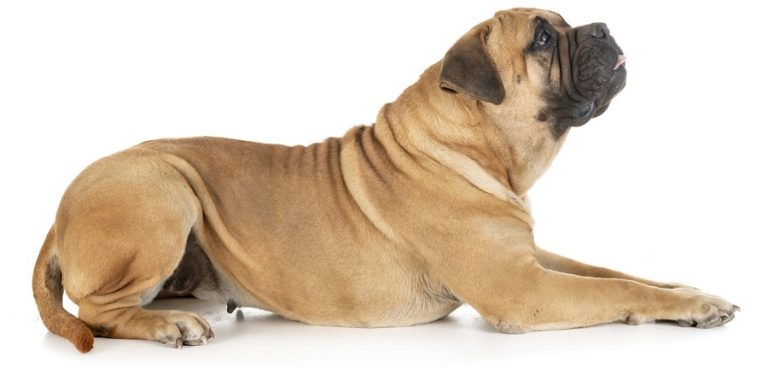Cocker Spaniel Growth Chart (Weight & Size Chart) – When Do Cocker Spaniels Stop Growing?
Cocker Spaniel is among the popular dog breeds in the American Kennel Registration statistics. They are active sporting dogs, medium-sized, and the smallest dog in the sporting group.
This article will give you information about the Cocker Spaniel growth chart, the expectations when they are growing, factors affecting their growth, health problems associated with them, and many more.
Cocker Spaniels are commonly known for their lively, intelligent behavior and they give good company.
These dogs are known as either American Cocker Spaniels or English Cocker Spaniels. These two types share the same roots and are often confused as one.
When Do Cocker Spaniels Stop Growing?

Have you recently adopted a puppy and been pondering the question of when cocker spaniels stop growing? The size of a fully grown dog impacts whether you have chosen the right pet for you.
Cockers like humans develop at an individual rate however, they reach a full-grown height between the ages of nine to twelve months. Their muscularity develops fully by eighteen to twenty-four months.
A fully grown male Spaniel has a height of about 15.5 and 16 inches (39 cm to 41.5cm) while the female is 15 and 15.5 inches (37 to 39 cm) tall. A cocker spaniel reaches full-grown weight by the ages of 9 to 12 months.
They reach a maximum weight by 24 months old and can maintain it throughout their lifetime if they exercise and feed well. A fully grown male Spaniel reaches a maximum weight of between 7 to 14 kg.
American Cocker Spaniel Weight Chart
Our weight chart will help you keep your puppy at the right weight. An adult cocker spaniel weighs between 7 to 14 kg. An American Cocker spaniel at three months weighs between 3.1 to 5.8 kg.
At six months, the American Cocker Spaniel gains an average weight of 5.6 kg for small puppies and 10.7 kg for large puppies. A cocker spaniel weighs between 7 to 13.8 kg at one year and it will be fully grown at around 14 months.
Always consult the cocker spaniel weight chart to as a quick and easy assessment of your puppy’s growth.
Cocker Spaniel Weight Chart
| Age | Weight in kg | Weight in lbs |
|---|---|---|
| 3 Months | 3.1 - 5.8 kg | 6.8 - 12.7 lbs |
| 4 Months | 4.1 - 7.7 kg | 9.0 - 16.9 lbs |
| 5 Months | 4.9 - 9.2 kg | 10.8 - 20.2 lbs |
| 6 Months | 5.6 - 10.7 kg | 12.3 - 23.5 lbs |
| 7 months | 6.0 - 11.6 kg | 13.2 - 25.5 lbs |
| 8 months | 6.4 - 12.5 kg | 14.1 - 27.5 lbs |
| 9 months | 6.8 - 12.9 kg | 14.9 - 28.4 lbs |
| 10 months | 6.9 - 13.2 kg | 15.2 - 29.1 lbs |
| 11 months | 7.0 - 13.6 kg | 15.4 - 29.9 lbs |
| 12 months | 7.0 - 13.8 kg | 15.4 - 30.4 lbs |
| 13 months | 7.0 - 13.9 kg | 15.4 - 30.6 lbs |
| 14 months | 7.0 - 14.0 kg | 15.4 - 30.8 lbs |
Cocker Spaniel Growth Chart- What to Expect
The cocker spaniel size chart shows that they have new skills and challenges at every stage. They reach their maximum weight and height earlier than they do their full potential emotionally, behaviorally, and mentally.
During the early stages of growth, a cocker puppy growth chart should be monitored regularly.

Birth – 2 Weeks
During this stage, puppies spend most of their time sleeping with all their energy focusing on growth. By birth, they can use their senses of touch and smell that help them identify their mothers. They need milk every two hours to help them with fast growth.
3 weeks – 12 weeks
Two to four weeks is a transitional time because their eyes open and they start to stand up. Their teeth pop out and they learn to move from their mother to relieve themselves. They begin to expand their vocabulary with whines, grunts, and barks.
In the third week, they begin to be independent, play with littermates, and regulate their body temperature.
At around four to twelve weeks, they start to socialize and accept those around them as family and friends. Their mental development grows, and they now need more nutrition than from their mom’s milk. They can be adopted at this stage.
4 months – 9 months
Cocker spaniel by the fourth month has fully developed sexually and are very curious about the world around them, they appear to get into everything at their sight and have boundless energy.
Between four to six months, puppies tend to fight, displaying fear, aggression, and testing boundaries as well as going through territorial issues.
These behaviors are healthy at this stage and pose nothing of concern. They go through emotional immaturity like it is in adolescence. Females may go into heat for the first time.

10 months – 18 months
At this stage, a Spaniel puppy will fully mature. They are fully grown with mental and emotional characteristics. They will get to their maximum height by the time they are twelve months.
Adults
Cocker spaniels attain a maximum weight by 24 months of age and live to the age of 12 to 15 years on average. The cocker spaniel is social and needs to be active all the time. Therefore, they should be kept active all the time.
How Big Do Cocker Spaniels Get?
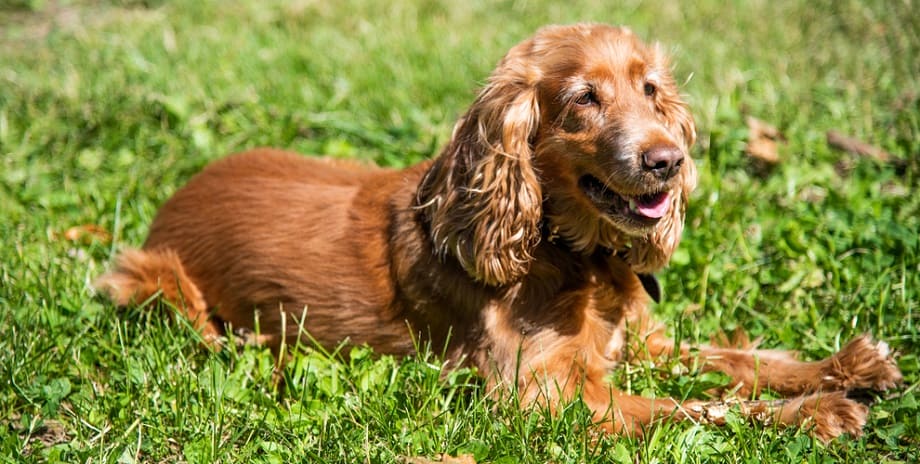
To predict the eventual size of your Cocker Spaniel, there are a few things that you can do. Firstly, you can refer to the growth chart within this article.
Secondly, you can look at your dog’s parents to make a calculated guess about what he will eventually grow to be.
Consult your breeder for this information. Your cocker spaniel will most likely be the average size of both his parents.
You can also look at his paws because dogs typically tend to grow into their paws. So if his paws are a lot bigger than the rest of his body then you know that he has quite a bit more growing to complete.
A DNA test has also been proven to be useful because they give an accurate account of your dog’s genealogy to better predict his size. In adulthood, cocker spaniels are around 13 to 15 kilograms in weight.
Will Neutering/Spaying Affect My Cocker Spaniel’s Growth?
Spaying and neutering have been known to affect the growth of dogs. Especially in male dogs, testosterone plays a part in their growth and neutering can disrupt this process leading to serious health problems later on. It is better to wait a while before having them neutered.
However, there are many benefits of spaying and neutering. For example, when dogs are castrated, they have a lower likelihood of prostate cancer, and they tend to be less aggressive.
Neutering can lead to a cocker spaniel that is more affectionate and happy.
For female dogs, you can prevent unwanted puppies and also reduce the risk of uterine and breast cancer. You will also reduce the risk of uterine infections when your female dog is spayed. She can also be less aggressive after she is spayed.
Cocker Spaniel Size Chart
Cocker spaniels are known to be small dogs and develop fairly quickly so having a height chart is important to track their progress of development.
You can measure their height by draping a flexible measuring tape from the ground up to their withers. Their withers are the highest point of their shoulder blades.
As a general rule, in adulthood, cocker spaniels usually stand at 15 to 16 inches for males and 15 to 15.5 inches for females who are known to be a bit smaller.
How To Properly Weigh And Measure A Cocker Spaniel?
Because cocker spaniels are smaller dogs it is easier to get them on a scale to weigh them as they develop. You simply need to keep them still on your bathroom scale and record their weight.
However, there may come a time when they get too big for the scale. Things get a bit more complicated in that case, but it is not impossible.
Simply get on the scale and take note of your weight. Then get on the scale while holding your Cocker Spaniel and the difference between those two measurements will be the weight of your Cocker Spaniel.
What Is A Cocker Spaniel’s Neck Size?
It’s important to have your dog’s correct neck size in order to choose a proper collar for him. You do not want a color that is too slack or too tight.
Too tight means your dog will be uncomfortable, and it can even cause some health problems. To slack means that the collar can slip off at any time. This is why having a proper neck size for your dog is important.
To measure the neck size of your cocker spaniel, you simply need to wrap a measuring tape around his neck, exactly where the color will be placed.
Then place two fingers underneath to make sure it is not too slack or too tight. Take note of this measurement which will be the neck size of your Cocker Spaniel.
Factors That Affect Cocker Spaniel Puppy Growth
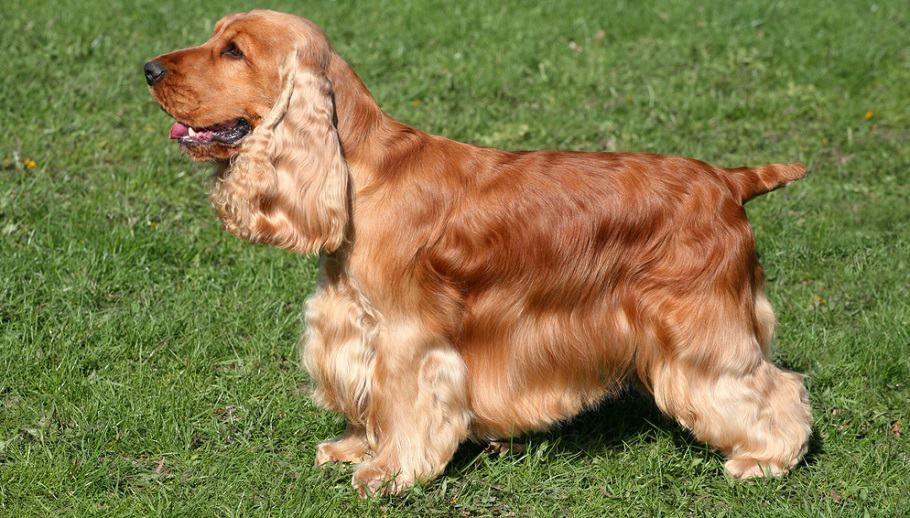
Genetics
Genetics plays a crucial role in the growth of your puppy. If you want to know the size with which the puppy can grow; check the size of the parent. Cocker spaniels can be affected by genetic disorders.
The most common genetic issues seen in these types of dogs are eye problems, bleeding disorders, back problems, knee problems, epilepsy, and skin diseases.
Nutrition
Nutrition can affect the growth of the cocker spaniel. During their growth stage, they need nutritious food because non-nutritious food can affect their development and growth.
The right way to know Spaniel’s right food is by talking to its veterinarian because they can help you in selecting the best diet for your puppy’s growth.
Physical Activity and Health
Exercise is a crucial component in the general health of every dog. Cocker spaniel puppy will flourish with lots of activity, playtime, and fun. However, training should be gentle to the developing muscles, joints, and bones.
This is because they can suffer injuries easily in their early stages of development.
Mental and physical activity can stimulate their bodies and minds and improve their growth. Inadequate exercise with unhealthy food can make Cocker Spaniels obese.
American Cocker Spaniel vs. English Cocker Spaniel
A while ago American and English Cockers were seen as the same until the 1930s when a decision to split them was made; because it became evident that cocker spaniels in England were different from those in the U.S. English Spaniels are larger than American Cocker Spaniel.
The English Cocker Spaniel has more height than the American Cocker Spaniel. American Cocker Spaniel has pronounced length of hair on the sides and legs.
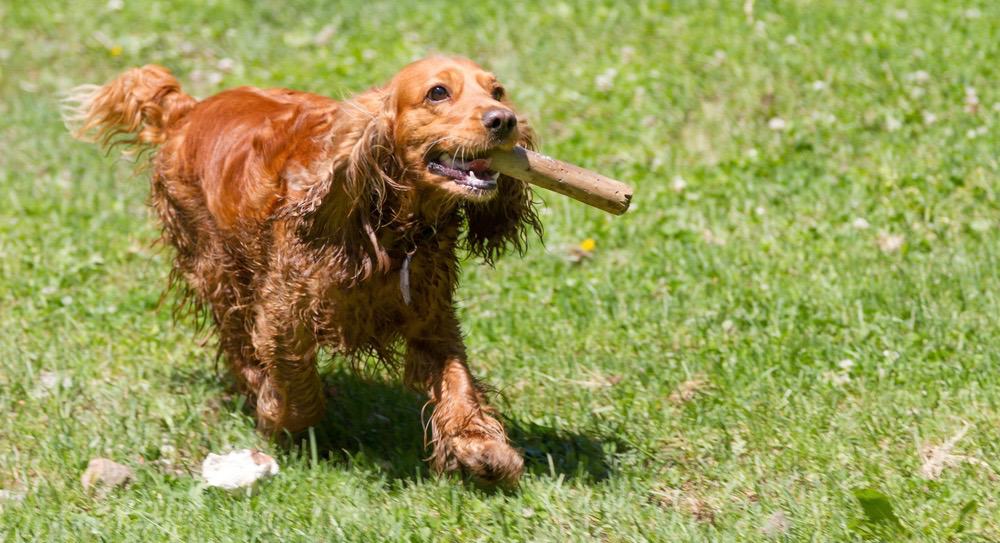
The English cocker spaniel has tight eyes that are slightly oval with a muzzle equal to the length of a plush and skull. American Cocker Spaniel has a shorter muzzle rounded skull and deep chiseling under the eyes shaped like almonds.
Both cocker spaniels are intelligent and responsive. They are always prepared to give you their unconditional love and they also demand great attention from the owner. They can easily get bored and can be destructive when left alone.
They are full of energy with sweet nature. They both have extensive grooming needs because they have abundant coat that can easily tangle. English Cocker spaniel is large and has a slightly longer lifespan than the American Cocker.
What Is The Life Expectancy Of Cocker Spaniels?
The average lifespan of a Cocker spaniel depends on genetics, diet, lifestyle, and health conditions. Generally, a healthy Cocker Spaniel lives for about 10 to 14 years. The cocker spaniel is prone to several health conditions which affect its well-being.
If you own a cocker spaniel, it is good you keep an eye on the issues and treat them early enough. English Cocker Spaniel has an average lifespan of 12 to 15 years while American spaniel lifespan is 10 to 14 years.
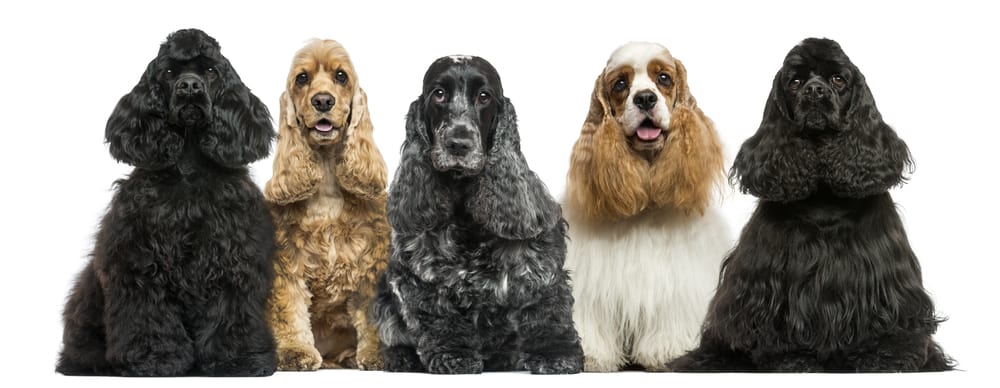 All these have exceptions because some may live up to even 19 years. With proper dental hygiene, health care, mental and physical stimulation plus a good diet Cocker Spaniels can live long enough.
All these have exceptions because some may live up to even 19 years. With proper dental hygiene, health care, mental and physical stimulation plus a good diet Cocker Spaniels can live long enough.
How Long Are Cocker Spaniels Pregnant?
Cockers Spaniels have the same pregnancy as other dogs. It goes to 63 days from the conception day; however, the right conception day is not always defined because you cannot ascertain the conception date.
Therefore 63 days is the general pregnancy length for a cocker spaniel.
How Many Puppies Do Cocker Spaniels Have?
A Cocker Spaniel can have up to twelve puppies and the least is three. The average litter size is between five to seven puppies. Spaniel’s litter size tends to vary because of the parent’s size, mother’s health, mother nature, or care during pregnancy.
What If My Cocker Spaniel Is Not The Right Weight?
For an ideal Cockers Spaniel’s right weight, consider the breed that is either English or American, the sex of the dog, age, health, and lifestyle. The English Cocker Spaniel is slightly larger than the American Cocker Spaniel and the females are smaller than males.
If your dog is overweight or underweight, that means he is unhealthy. It is difficult to determine the right weight for your dog, therefore, a visit to your vet will help you know your dog’s right weight.
How Much Does It Cost To Own A Cocker Spaniel?
The following is the cost to put into consideration when planning to purchase a Cocker Spaniel:
Purchase cost: Adopting an older cocker spaniel can save you a lot on costs and the puppy will get a home. If you are buying a puppy from a breeder, put into consideration the cost. Ensure that the breeders have done extra health tests and meet good standards.
Set up costs: Puppy vaccines are a health check for a Cocker Spaniel. If it is a rescued dog, reputable centers will vaccinate them for you with booster vaccines needed for their continued immunity.
Neutering is arranged for a dog at six months old but with the advice of your vet. Confirm prices with your local practice because they will depend on where you live and the veterinarian.
Ongoing costs: Food and preventive healthcare create a budget as well as time-to-time visits to the vet. Vet bills, pet insurance, and accessories such as poo bags to be budgeted, sums up the costs of your Cocker Spaniel.
Other costs include the boarding cost when traveling, training, dog walkers, and daycares.
Cocker Spaniel Genetics And Common Health Problems
Several health problems affect Cocker’s spaniels and may contribute to their shortened lifespan.
Some problems are inherent to their breed while others result from poor breeding, lack of exercise, poor diet and not visiting the veterinarian when needed. The following are common health problems for Spaniels:
Genetic predisposition
Cataracts in dogs are like Progressive Retinal Atrophy because they all lead to impaired visual capabilities. However, this is the cloudiness of the eye lens rather than weakening. Thick cataracts may lead to blindness or glaucoma.
PRA or Progressive Retinal Atrophy is a condition in dogs that causes the dog’s retina to deteriorate causing canine blindness.
Epilepsy can also affect Cocker Spaniels. It is a neurological disorder caused by a sudden loss of consciousness, recurrent episodes of sensory disturbance, or convulsions.
Elbow dysplasia is an elbow disease that results because of growth disturbance in the joint. Possible causes of this problem include cartilage growth defects, genetics, and trauma.
Patellar Luxation occurs when a dog’s kneecap or patella moves out of its normal position. It is usually painful and may lead to the pup’s lameness.
General health issues
Dental diseases – it is the most chronic health issue in pets. It can start with tartar build-up which leads to infections. It is good to prevent gum diseases to avoid further complications.
Infections – cocker spaniels are prone to viral and bacterial infections such are rabies and parvo. Prevent these infections through vaccination.
Parasites – bugs and worms can invade the cocker spaniel’s body. They can be transferred to family members, therefore, perform regular testing of your pet.
Frequently Asked Questions
What is the purpose of the Cocker Spaniel growth chart?
The Cocker Spaniel growth chart on dogfoodsmart.com serves as a valuable tool to monitor the growth and development of Cocker Spaniel puppies. It provides insight into the expected weight and height ranges for different age milestones, enabling owners to ensure their puppies are growing appropriately.
What are the typical characteristics of Cocker Spaniels?
Cocker Spaniels have a reputation for being gentle and friendly. They are wonderful family pets because they are intelligent and eager to please. They have a reasonable amount of energy and should exercise frequently to keep both their minds and bodies active. Additionally, Cocker Spaniels have a stunning, silky coat that requires regular grooming to prevent matting.
Are Cocker Spaniels good with children and other pets?
Yes, Cocker Spaniels are generally good with children and other pets when properly socialized and trained. They have a gentle and patient demeanor, which makes them suitable companions for families. However, it’s important to supervise interactions between young children and dogs to ensure mutual respect and safety.
Do Cocker Spaniels have any specific health concerns?
Cocker Spaniels are prone to certain health issues, including ear infections, eye problems (such as cataracts and progressive retinal atrophy), and certain skin conditions. They may also be susceptible to hip dysplasia and luxating patellas (loose kneecaps). Regular veterinary check-ups, proper grooming, and a nutritious diet can help maintain their overall health and address any potential health concerns.
How much exercise do Cocker Spaniels require?
Cocker Spaniels have a moderate energy level and benefit from regular exercise to keep them physically and mentally stimulated. Daily walks, playtime, and interactive activities are recommended. Engaging them in mentally stimulating games and training sessions can help prevent boredom and undesirable behaviors.
What is the average lifespan of a Cocker Spaniel?
On average, Cocker Spaniels have a lifespan of around 10 to 14 years. However, this can vary depending on various factors, including genetics, overall health care, and lifestyle. Providing a balanced diet, regular exercise, routine veterinary care, and a loving environment can contribute to a longer and healthier life for your Cocker Spaniel.
Final Thoughts
Hopefully, this article has given more information about the cocker spaniel growth chart and what to expect during their growth stages of life. This way, you can take care of them and ensure they have a healthy and happy life.

